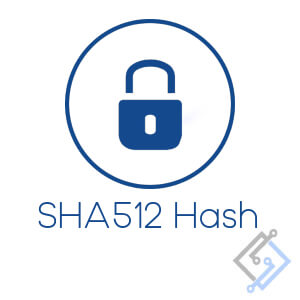
- Sha512 hash password creator update#
- Sha512 hash password creator password#
- Sha512 hash password creator free#
To make the passwords more secure, store it using salt.
Sha512 hash password creator password#
This is a more secure way to store passwords because hackers cannot use the dictionary method to crack the hashes.įor example, if a user's password is 123456, using a random salt will secure his passwords from a dictionary attack because password hash is different using salt than without salt.Ĭurrently, nobody found a collision, but there are many methods still available to crack it. The salt is a sequence of random characters combined with the initial password and the result is hashed. This means that from the result of hashing, you cannot get the initial value, so it's irreversible. The biggest difference is that hashing is a one-way function and encryption can be two ways.
What's the difference between hashing and encryption?. Sha512 hash password creator free#
Optional: Register to use our free REST API to get the hash. Optional: Select the checkbox to include salt and specify the salt or use the default value. The steps are similar for all hash function: Earl C.As the name says, SHA512 is on 512 bits and uses 80 rounds for the hash function. Tony G on Fixing VSCode when it keeps dropping ssh connections. EDWARD on Creating AWS Elastic Filesystems (EFS) with Terraform. 
Ruby III on Creating AWS Elastic Filesystems (EFS) with Terraform
Eduardo on Fixing VSCode when it keeps dropping ssh connections. Muhtasim Fuad Jeet on Fixing VSCode when it keeps dropping ssh connections. NotAnAppleGuy on Turn off Apple Wallet / Apple Pay notifications and nag screens. Ruby III on Turn off Apple Wallet / Apple Pay notifications and nag screens  Getting NVIDIA NGC containers to work with VMware PVRDMA networks. Setting up a 100GbE PVRDMA Network on vCenter 7. Fixing VSCode when it keeps dropping ssh connections. Allow ping from specific subnets to AWS EC2 instances using Terraform. Updating ESXi root passwords and authorized ssh keys with Ansible. Setting up NFS FSID for multiple networks. Calculating the value for 64bitMMIOSizeGB. Gitlab: The source branch does not exist. The crypted password is encrypted with a SHA512 one-way hash and a random 16 character salt, so you can check the playbook into a Git repository without revealing your password. Since you used the interactive shell the plaintext password that you entered is not saved into the Linux host’s history file and is not visible to anyone running ps. Type Ctrl-D to exit the interactive openssl shell. Copy and paste the hashed version of the password into Ansible, and the next time you run Ansible on a host the user’s password will be updated. Just enter the password that you want to use, hit enter, and openssl will respond with the hashed version. This opens an interactive shell to openssl. To generate the hashed password use the openssl passwd command on any Linux host: openssl passwd -6 -stdin Password: "$6$wLZ77bHhLVJsHaMz$WqJhNW2VefjhnupK0FBj5LDPaONaAMRoiaWle4rU5DkXz7hxhl3Gxcwshuy.KQWRFt6YPWXNbdKq9B/Rk9q7A."
Getting NVIDIA NGC containers to work with VMware PVRDMA networks. Setting up a 100GbE PVRDMA Network on vCenter 7. Fixing VSCode when it keeps dropping ssh connections. Allow ping from specific subnets to AWS EC2 instances using Terraform. Updating ESXi root passwords and authorized ssh keys with Ansible. Setting up NFS FSID for multiple networks. Calculating the value for 64bitMMIOSizeGB. Gitlab: The source branch does not exist. The crypted password is encrypted with a SHA512 one-way hash and a random 16 character salt, so you can check the playbook into a Git repository without revealing your password. Since you used the interactive shell the plaintext password that you entered is not saved into the Linux host’s history file and is not visible to anyone running ps. Type Ctrl-D to exit the interactive openssl shell. Copy and paste the hashed version of the password into Ansible, and the next time you run Ansible on a host the user’s password will be updated. Just enter the password that you want to use, hit enter, and openssl will respond with the hashed version. This opens an interactive shell to openssl. To generate the hashed password use the openssl passwd command on any Linux host: openssl passwd -6 -stdin Password: "$6$wLZ77bHhLVJsHaMz$WqJhNW2VefjhnupK0FBj5LDPaONaAMRoiaWle4rU5DkXz7hxhl3Gxcwshuy.KQWRFt6YPWXNbdKq9B/Rk9q7A." Sha512 hash password creator update#
It’s a giant pain in the ass if you need to update the password on many machines.Ī better way is to hash the password once using openssl and store the hashed version of the password in your Ansible playbooks: - name: Set the user's password This might be OK if you’re just updating one machine.
Attempting to make the play idempotent, by using update_password: on_create, means that you can no longer update the password using Ansible. The play is not idempotent, since the SHA512 filter will re-hash the password every time you run the play, resetting the password each time the play is run.  Storing your passwords in plain text is a bad idea, since anyone who can read your Ansible playbook now knows your password. Storing your passwords in plain text is a bad idea This is a bad practice for a number of reasons. Some Ansible docs suggest storing your passwords in plain text and using the Ansible SHA512 filter to hash the plaintext passwords before passing them to the user module. The password must be passed to Ansible in a hashed password format using one of the hash formats supported by /etc/shadow. The Ansible user: command allows you to add a user to a Linux system with a password.
Storing your passwords in plain text is a bad idea, since anyone who can read your Ansible playbook now knows your password. Storing your passwords in plain text is a bad idea This is a bad practice for a number of reasons. Some Ansible docs suggest storing your passwords in plain text and using the Ansible SHA512 filter to hash the plaintext passwords before passing them to the user module. The password must be passed to Ansible in a hashed password format using one of the hash formats supported by /etc/shadow. The Ansible user: command allows you to add a user to a Linux system with a password.







 0 kommentar(er)
0 kommentar(er)
